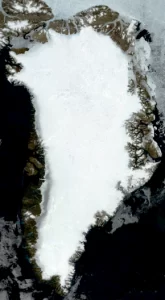Our mission is to unravel how dark particles (black) and microbial processes (bloom) darken and accelerate the melting of the Greenland Ice Sheet.

The Greenland Ice Sheet is the second biggest on Earth (after the Antarctic Ice Sheet), and is made up of approximately 1.7 million square kilometers of frozen water, roughly 7-times the size of the UK. However, as with all of the Arctic, melting of the Greenland Ice Sheet is accelerating. If fully melted, the Greenland Ice Sheet would add around 7.2 m to global sea levels, so its crucial that we understand what is driving the increasing melt, and how the stability of the ice sheet will change in the future.
Black and Bloom’s mission is to reveal how dark particles and microorganisms (pigmented bacteria and algae) that live in melt water on the surface of the ice are ‘amplifying’ ice sheet melt. We believe that by darkening the ice surface, these particles and microbes lower the ice albedo (reflectivity) and absorb more of the suns heat, increasing the melt. Climate change will likely exacerbate this process, by providing more melt water for microorganisms to thrive in.
To complete our mission, we’ll be running several expeditions out onto the ice sheet over the next 4 years, to measure and manipulate the ice surface. We’ll then use our data to predict how the ice sheet will change in the future with on-going climate change.
Have a look at the behind our project to see how we’ll be tackling these problems, and follow our news and twitter feed @Glacier_Albedo to keep track of our progress
